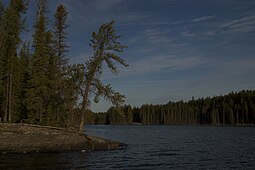| Niyanun Lake | |
|---|---|
 Niyanan Lake Niyanan Lake | |
  | |
| Location | Manitoba |
| Coordinates | 54°43′20″N 101°23′26″W / 54.72222°N 101.39056°W / 54.72222; -101.39056 |
| Lake type | Glacial Lake |
| Primary inflows | Mistik Creek |
| Primary outflows | Mistik Creek |
| Basin countries | Canada |
| Max. length | 0.8 km (0.50 mi) |
| Max. width | 0.4 km (0.25 mi) |
| Surface elevation | 315 m (1,033 ft) |
| Settlements | None |
Niyanun Lake is a glacial lake on the Mistik Creek chain in the Hudson Bay drainage basin in the Northern Region of Manitoba, Canada.
It sits in the Churchill River Upland portion of the Midwestern Canadian Shield forests which consist of mixed deciduous and coniferous trees. The lake is also situated on the well known "Mistik Creek Loop", a remote canoe route 95 kilometres (59 mi) in length which can be paddled in four days.
Niyanun means 'five' in Cree, as all of the fourteen lakes on Mistik Creek are named in numeric order in Cree.
The lake contains northern pike. The region around the lake consists of rocky parallel ridges with poorly drained areas of muskeg and irregular stony shorelines due to intense glaciation.
See also
References
- ^ Manitoba Conservation and Water Stewardship (Summer 2012). Neso Lake Provincial Park Draft Management Plan (PDF). Manitoba Conservation and Water Stewardship. p. 2. Archived from the original (PDF) on 4 March 2016. Retrieved 6 September 2017.
- Schick, RoseAnna (21 June 2003). "Live the song of the paddles". Winnipeg Free Press. Retrieved 18 May 2014.
- Berard, Real (1968). Mistik Creek Canoe Route. Manitoba Dept. of Natural Resources. Archived from the original on 18 May 2014.
- Place-Names of Manitoba. Canadian Board on Geographical Names. 1933. p. 60.
- Place-Names of Manitoba. Canadian Board on Geographical Names. 1933. p. 67.
- "Master Angler Awards: Niyanun Lake". Travel Manitoba. Retrieved 18 May 2014.
- Lee, Eun (2000). "Temporal Distribution of Ectomycorrhizzal Fungi and Pollen" (PDF). Korean Journal of Ecology. 23 (2): 169–173. Retrieved 18 May 2014.